Introduction
As a leading control valve manufacturer in China, we deliver premium valves and control actuators expertly designed to meet a wide range of industrial requirements.
Across industries such as power generation, chemical processing, HVAC, and water treatment, precise fluid flow control is essential. The 3-Way Globe Control Valve offers an effective, versatile solution for applications requiring flow mixing or diversion. Its distinctive globe-shaped body and internal mechanism allow for accurate modulation, stable performance, and tight shut-off.
This article delves into the design, operation, configurations, advantages, and industrial uses of 3-way globe control valves, along with important factors for selection and maintenance.
What Is a 3-Way Globe Control Valve?
A 3-way globe control valve features three ports—commonly labeled A, B, and AB (or M)—enabling it to either mix two fluid streams into one or divert one stream into two different flow paths. Internally, a movable plug or disc attached to a stem regulates flow by changing the flow path based on its position. Actuators—manual, pneumatic, electric, or hydraulic—control the plug movement.
This valve type can be configured for mixing, diverting, or universal (multi-functional) flow control.
Valve Configurations
1. Mixing Valve
Two inlet ports (A and B) feed separate fluid streams into the valve, which mixes them inside and sends the combined flow out of the single outlet (AB). The plug adjusts the ratio of each inlet flow to precisely control the mixture.
Applications:
- Heating/cooling systems (mixing hot and cold water)
- Process temperature regulation
- Chemical or gas blending
2. Diverting Valve
One inlet (A) feeds fluid, which is directed to either of two outlets (B or AB) depending on plug position. This allows flow switching between different lines or equipment without multiple valves.
Applications:
- Switching between parallel processing lines
- Directing coolant or lubricants
- Flow alternation for maintenance or cleaning
3. Universal Valve
Supports both mixing and diverting functions, allowing fluid to flow in or out of any two ports. This multi-functional design is ideal for complex systems requiring flexible flow control.
Applications:
- Complex thermal or chemical dosing systems
- HVAC loops with reversible flow
How Does It Work?
The valve’s plug moves linearly within the body to open or close flow paths:
- Mixing: Combines two inlet streams into one outlet, controlling the mix ratio.
- Diverting: Directs one inlet stream to one of two outlets.
- Universal: Enables any combination of mixing or diverting through intelligent plug positioning.
Actuators, controlled by process systems, position the plug for precise flow modulation.
Actuation Methods
- Manual: Simple handwheel or lever control for infrequent adjustments.
- Pneumatic: Air-powered actuators offering fast, reliable control in process environments.
- Electric: Precise positioning, ideal for remote operation and digital integration.
- Hydraulic: High force for demanding, high-pressure applications.
Actuators often pair with positioners and sensors for automation and feedback.
Key Advantages
- Versatility: Handles mixing and diverting, reducing the number of valves needed.
- Compactness: Saves space by replacing multiple 2-way valves.
- Precision: Globe design provides excellent throttling and shut-off.
- Durability: Suitable for high pressures and temperatures with diverse material options.
- Maintainability: Modular parts allow straightforward inspection and repair.
Industrial Applications
- HVAC: Temperature regulation by mixing or diverting water flows.
- Chemical Processing: Precise blending and flow switching.
- Power Plants: Managing steam, water, and condensate in boiler systems.
- Food & Beverage: Mixing ingredients and directing cleaning fluids.
- Pharmaceuticals: Accurate dosing and sanitary flow control.
- Oil & Gas: Controlling fluids in refining and separation processes.
Selection and Design Considerations
- Body Material: Stainless steel, bronze, or other corrosion-resistant alloys for harsh media.
- Trim Design: Plug and seat types affect control precision and sealing.
- Flow Capacity (Cv): Must meet system flow demands.
- Pressure/Temperature Ratings: Compatibility with operating conditions.
- Actuation and Controls: Automation needs dictate actuator type and interface.
Maintenance Tips
- Inspect regularly for leaks, wear, and corrosion.
- Lubricate moving parts as needed.
- Calibrate actuators and control devices to ensure accuracy.
- Clean internal components to prevent buildup in mixing valves.
- Address common issues like plug wear, stem sticking, and actuator faults promptly.
Conclusion
The 3-way globe control valve is a versatile, efficient component essential for mixing and diverting fluid flows in diverse industrial processes. Its ability to replace multiple valves with a single unit simplifies system design, improves control precision, and enhances operational flexibility.
From HVAC temperature control to complex chemical dosing, these valves deliver reliable, precise performance. As automation and system complexity grow, the multifunctional 3-way globe valve will continue to be a key player in advanced fluid control solutions. Know more about Google SEO Directory





Comments